Pigs Like Animal That Live in New Mexico
Pigs Like Animal That Live in New Mexico
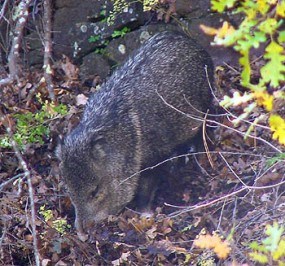
NPS Photo by Barry Nielsen
Mammal species in the monument might not always be the easiest to observe, merely the park is abode to a broad variety of them. The most frequently seen are mule deer, javelina, and squirrels, but with patience, knowledge of their habits, and a peachy middle, other species can exist constitute too. Gray foxes, beavers, raccoons, bats, small rodents, coyotes, desert cottontails, bobcats, and even black bears and mountain lions have all been spotted here! Below yous can notice data well-nigh some of our more than unusual and frequently sited neighbors.
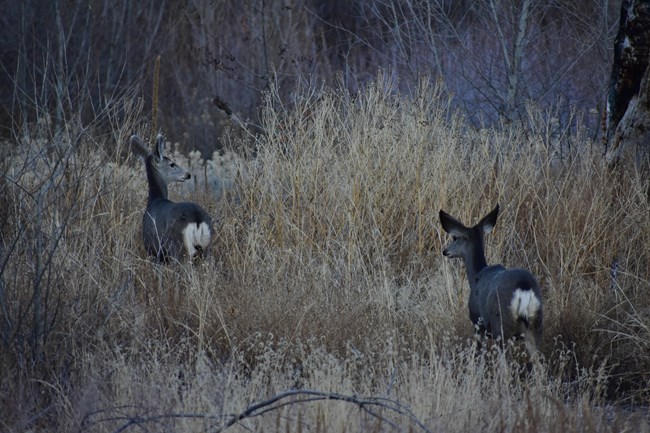
NPS Photograph
Mule deer
Also known every bit: muley, black-tailed deer, burro deer
Size: Total length about 63 inches (5 feet), adults boilerplate weight 150 pounds for does and 225 pounds for bucks.
Habitat: They can be found from desert shrub lands to coniferous forests; prefer vegetation or physical features that provide cover.
Named for their huge ears and black-tipped tails, they can be easily distinguished from their cousins, the white tail, by their 'boxy' body shape and distinctive bouncy gait. The males' antlers are too forked or branched evenly. Their coloration varies from nighttime gray in winter to reddish brownish in summertime.
Virtually active in the early forenoon and late evening, these deer are intermediate feeder/browsers, preferring leaves and twigs to grass.
In wild populations, males seldom live longer than 8 years, and females seldom live longer than fourteen years. In 1926, mule deer reached a population low point of around 41,000 in New Mexico. Today, at that place are approximately 300,000 mule deer in the country.
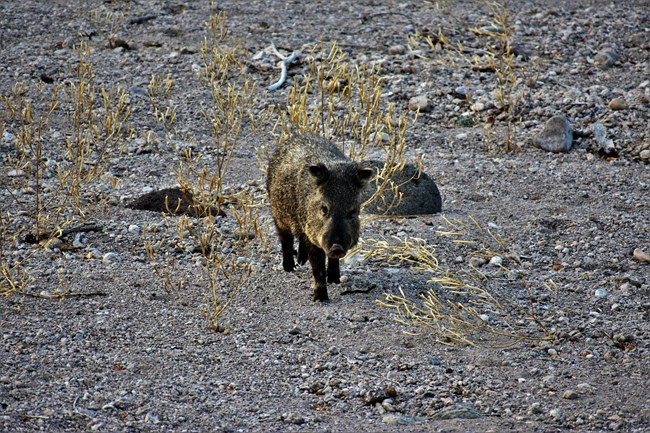
NPS Photo
Collard peccary
Too known as: javelina, musk grunter, skunk grunter
Size: About 36 inches (three feet) olfactory organ to tail; weighs xxx to lx pounds.
Habitat: In the Southwest, desert grasslands and brushy foothills, usually near h2o. They can also exist found in foothills in chaparral, oak and pino woods.
The Collared peccary resemble pigs, but are from a different family than pigs and wild boars. They are different in size (smaller), appearance, number of teeth and a distinctive musky aroma. The scent gland helps these social animals place who is and who is not in their family unit, as well equally the boundaries of their territory. They rub each other several times a twenty-four hours to transfer their olfactory property, every bit well as 'mark' their territory with the scent gland. Groups can be as large every bit xxx, but usually 20 or so. They can alive a relatively long life of up to 20 years, but average lifespan is 13.
Collared peccaries are primarily herbivorous and have complex stomachs for digesting coarsely chewed food. Favorite foods include mesquite beans and fruits and pads of prickly pear cactus. They as well use their tough, deejay-shaped snout to turn over dead vegetation in search of roots and new shoots. Despite all this supplementary diet, the main dietary components of this species are agaves and prickly pears.
They take poor eyesight merely dandy sense of odour. At the commencement sign of danger, they freeze, emit their musky scent and click their tusks. More often than not, they volition abscond rather than behave aggressively.
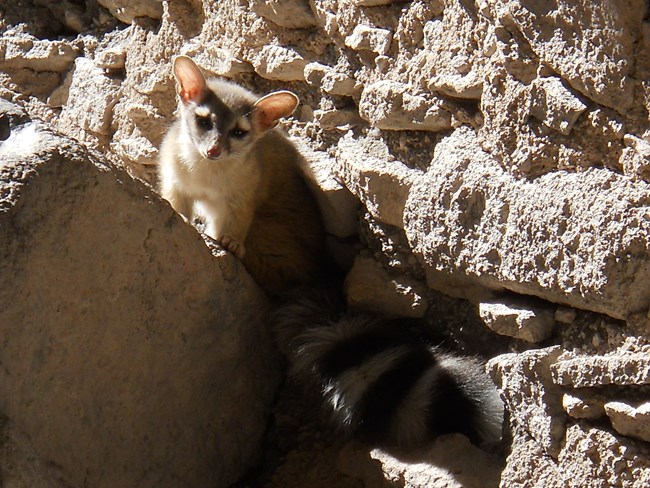
NPS photograph
Ringtail
Also known as: ringtail cat, miner's cat
Size: Total length from nose to tip of tail, about 30 inches; tail alone most fifteen inches.
Habitat: Cliffs, rocky canyons and other broken terrain; as well establish along brushy arroyos in the lower desert.
Several of the alternate or common names ending in 'cat' reflect this creature's catlike slender body and anxiety, as well as its finesse at climbing and its pouncing hunting fashion. Their considerable tail provides balance for negotiating narrow ledges and limbs, even allowing them to reverse directions by performing a cartwheel. They tin rotate their hind feet 180 degrees, giving them purchase for rapidly descending cliffs or trees also as cacti. Its face up, however, tends to resemble a fox, thus the scientific name which translates to "clever little fox." Almost conspicuous in appearance is its tail, with about seven black and seven white rings, ending in a black tip.
These creatures are strictly nocturnal and are rarely seen by humans. The ringtail is an omnivore, eating both meat and plant textile. They swallow rodents, insects, birds and eggs, and fruits of plants like persimmon, hackberry, and prickly pear.
Its tracks are like those of a house true cat; but a house cat impress volition have four toe impressions, and a ringtail will exit five toe impressions. The ringtail has short, non-retractable claws, just claw marks usually do non appear with its tracks.
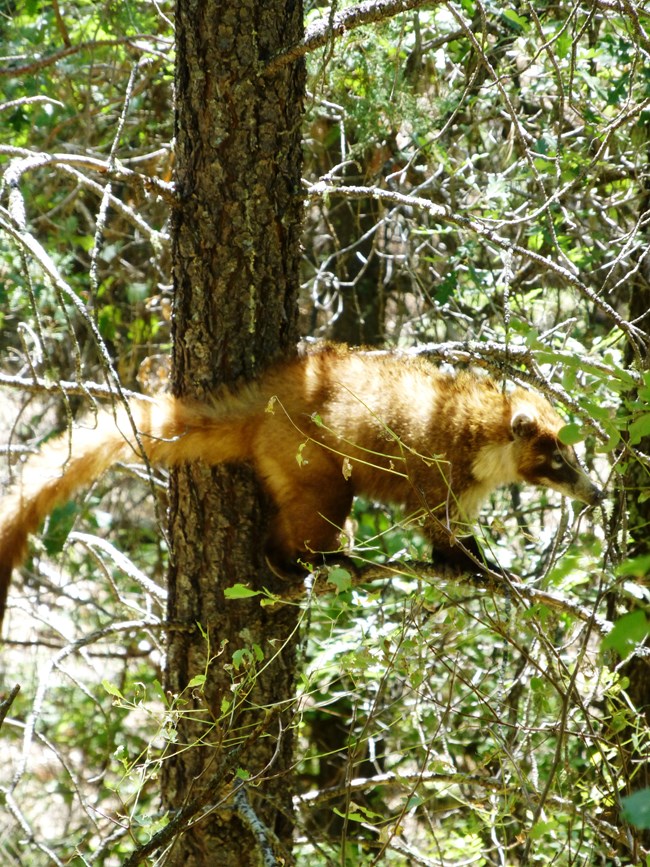
NPS Photograph
White-nosed coati
Also known equally: coatimundi, hog-nosed coon, gato solo
Size: Total length about 41 inches, of which half is its tail. Males are much larger than females. Small females tin can weigh as picayune every bit 5.five lbs, while large males tin can weigh every bit much as 27 lbs.
Habitat: Oak woodlands, adjacent grasslands, and mountain ranges
These animals are in the raccoon family, but dissimilar their cousins, they are diurnal (roaming and hunting during the day) and love company. They live and forage in bands of 4 to l, typically adult females and their young. The males leave the group at historic period two and rejoin merely when finding a mate.
With their tails up in the air, and their flexible noses to the basis, these animals 'root' through the soft wood floor to unearth pocket-sized mammals and reptiles, insects, worms and tubers (root plants). Using their long curved forepart claws, they shred logs on the ground, overturn rocks, and dig in soil to find insects and modest animals to eat. Talented climbers, they find fruit, berries and bird eggs in copse, using their long tails for balance every bit they leap from limb to limb.
The White-nosed coati is plantigrade with shorter forelegs than hind legs. The feet are blackness and take naked soles. The forefeet also accept bent claws. The tapering tail of extreme length is covered with black rings and held cock while walking. In the wild, these animals have a life expectancy of approximately xiv years. White-nosed coatis are classified as an endangered species in New United mexican states.
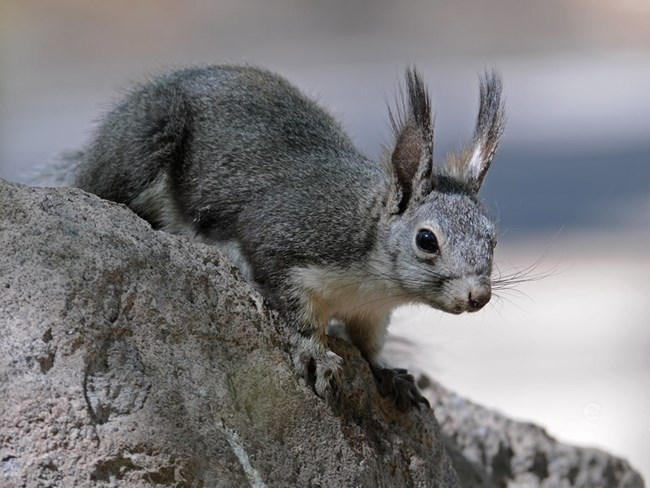
NPS Photo
Abert'due south squirrel
(pronounced a-bear)
Also known as: Tassel-eared squirrel
Size: Total length nose to tip of tail nigh 24 inches; tail alone about 12 inches
Habitat: Generally Ponderosa pino forests, sometimes mixed coniferous forests. At that place are three dissimilar subspecies in New Mexico.
Abert's squirrels depend on the Ponderosa pine for food, shelter, and nesting sites. They eat the Ponderosa seeds, bawl, buds and male cones. Clipped needles on the footing can indicate the squirrels feeding above. They too bask mushrooms, depending on their moisture content for h2o, forage for mistletoe, acorns, insects, occasionally carrion (dead animals), shrubs, and grasses. They also crumb on shed antlers and other bones for mineral content.
These squirrels exercise not hibernate but may sleep through periods of cold weather. Unlike other squirrels, they do not 'cache,' or store food.
Abert'south squirrels show a slap-up bargain of social communication during the spring at the start of breeding flavor. These squirrels are much less social in the summer, autumn and winter. They are mostly solitary and maintain distance amid individuals. A somewhat contradictory report observed most squirrels sharing nests frequently. They use several communication behaviors: vocal, visual, touch, and smell or taste. These squirrels make a diverseness of sounds including clucks, barks, screeches and squeals. Their sounds may exist identified from other nearby squirrel species due to its high pitch.
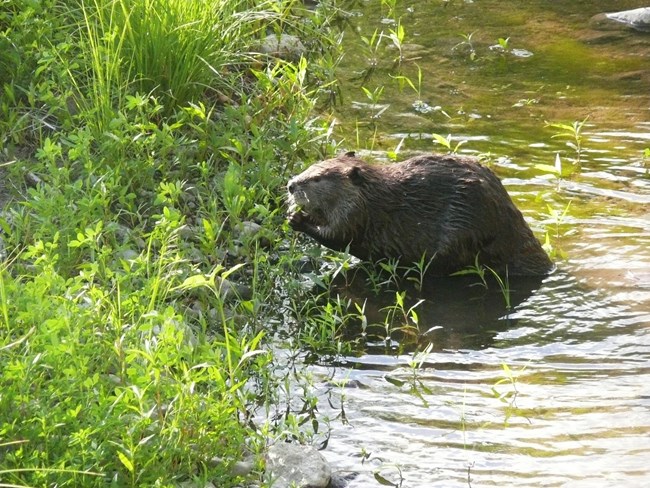
American beaver
Size: Body 25 to 35 inches, tail, 9 to 12 inches
Habitat: Streams, rivers, and lakes with copse on the banks
Nearly: Outside of human beings, beavers impact landscapes more than whatever other animal in North America. When they create the dams they are and then famous for, they establish wetlands that slow floodwaters, forestall erosion, and raise water tables. This process creates varied and diverse ecosystems that affect all of the wild animals in the area while the creation and subsequent filling of ponds tin affect the mural for thousands of years even afterward they get out the area.
Beavers are the largest rodent in North America. They feed on bark and cambium (the soft underbark of copse) and often completely chew through trees for use in structure of dams and lodges. For this reason, their front teeth never finish growing.
Beavers live in lodges. These are often congenital out of the copse they cut down, woven together with sticks and grass then plastered with mud. Particularly in the Southwest U.South. where riparian trees tin be scarce, they will create lodges in the sandy or dirty banks of the river they are residing in. In that location will often exist up to eight individuals living in a social club with younger siblings living with the parents for up to two years before leaving to establish their own lodge.
Beavers have a very distinct tail that is broad and flat, covered with big black scales. The tail, along with their webbed anxiety, assist in pond and is used to warn other beavers past slapping it confronting the water loudly.
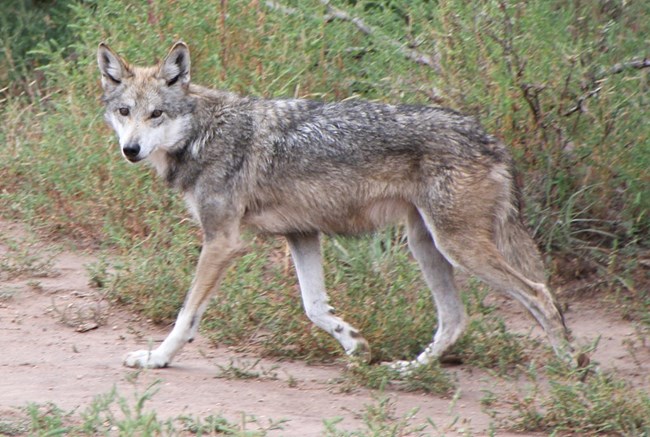
Mexican gray wolf
Size: Up to v and ½ feet from tip olfactory organ to tip of tail, is 28 to 32 inches tall at the shoulder, and weighs 50 to 80 pounds as an developed
Habitat: Rangeland, desert and forest
About: The Mexican Grayness wolf became endangered officially in the U.s. in 1976, due to unregulated trapping, hunting and poisoning. It is the smallest of North America's grayness wolves, and is distinguished by its smaller, narrower skull and its darker pelt, which is yellow-grey and heavily clouded with black over the dorsum and tail. Its ancestors were likely the outset gray wolves to enter North America. The Mexican wolf was first described as a singled-out subspecies in 1929 past Edward Nelson and Edward Goldman.
All wolves, including the Mexican Gray, have complex social lives. The grouping is ordinarily 5 or six in number, led by a ascendant breeding pair. All adults in the pack share the pup-raising duties, such as protecting, feeding, and training to stalk and hunt. Pups mature at the age of 2 years and become adult members of the pack at that time. Wolves are carnivores (meat eaters), hunting small and big prey, from mice and rabbits to deer and elk.
Other Common Mammals
| Deer Family (Cervidae) Elk (Cervus elaphus) Mule deer (Odocoileus hemionus) White-tailed deer (Odocoileus virginianus) New World Pig Family (Tayassuidae) Collared peccary (Pecari tajacuu) Dog Family (Canidae) Coyote (Canis latrans) Gray play a joke on (Urocyon cinereoargenteus) Mexican gray wolf (Canis lupus baileyi) Cat Family unit (Felidae) Bobcat (Lynx rufus) Mount lion (Puma concolor) Skunk Family (Mephitidae) Hooded skunk (Mephitis macroura) Striped skunk (Mephitis mephitis) White-backed squealer-nosed skunk (Conepatus mesoleucus) Raccoon Family (Procyonidae) Northern raccoon (Procyon lotor) Ringtail (Bassariscus astutus) White-nosed coati (Nasua narica) Bear Family (Ursidae) American black bear (Ursus americanus) Bats (Chiroptera) Big free-tailed bat (Nyctinomops macrotis) Brazilian free-tailed bat (Tadarida brasiliensis) | Bats (cont.) Big brown bat (Eptesicus fuscus) Silverish-haired bat (Lasionycteris noctivagans) Hoary bat (Lasiurus cinereus) Southwestern myotis (Myotis auriculus) California myotis (Myotis californicus) Modest-footed myotis (Myotis leibii) Fiddling brownish myotis (Myotis lucifugus) Rabbits & Hare Family unit (Leporidae) Black-tailed jackrabbit (Lepus californicus) Desert cottontail (Sylvilagus audubonii) Rodents (Rodentia) American beaver (Castor canadensis) Common muskrat (Ondatra zibethicus) Brush mouse (Peromyscus boylii) Deer mouse (Peromyscus maniculatus) Piñon mouse (Peromyscus truei) Western harvest mouse (Reithrodontomys megalotis) Mexican woodrat (Neotoma mexicana) Western white-throated woodrat (Neotoma albigula) Mexican vole (Microtus mexicanus) Botta'due south pocket gopher (Thomomys bottae) Abert's squirrel (Sciurus aberti) Rock squirrel (Spermophilus variegatus) Cliff chipmunk (Tamias dorsalis) Crawford's gray shrew (Notiosorex crawfordi) |
Pigs Like Animal That Live in New Mexico
Source: https://www.nps.gov/gicl/learn/nature/mammals.htm


Comments
Post a Comment